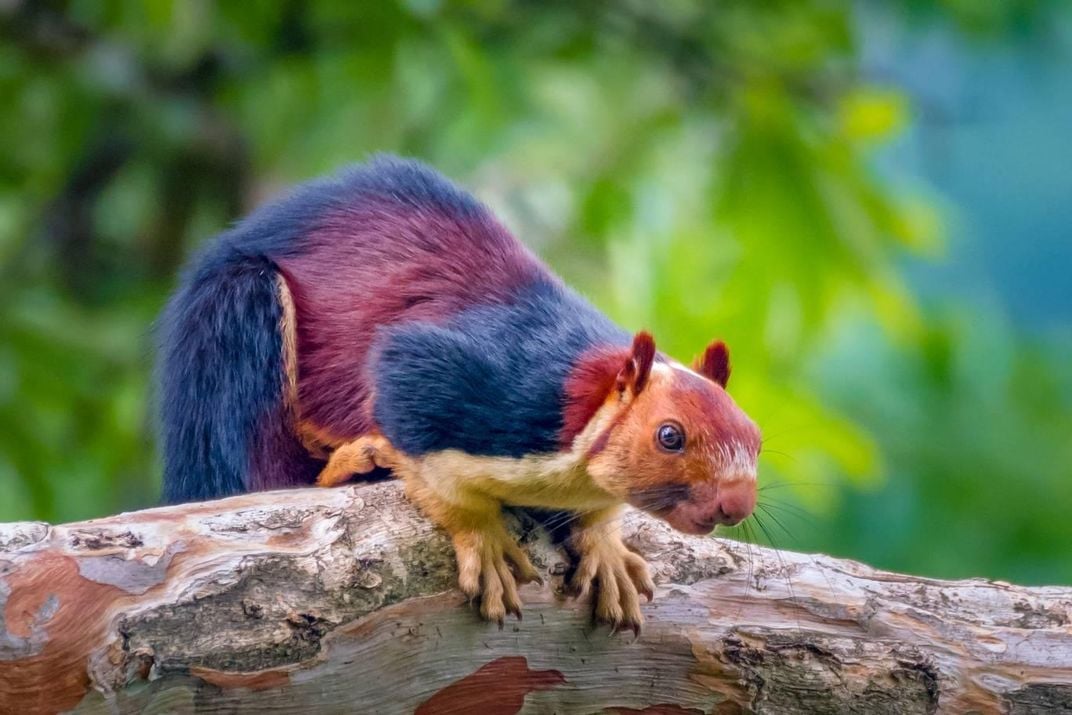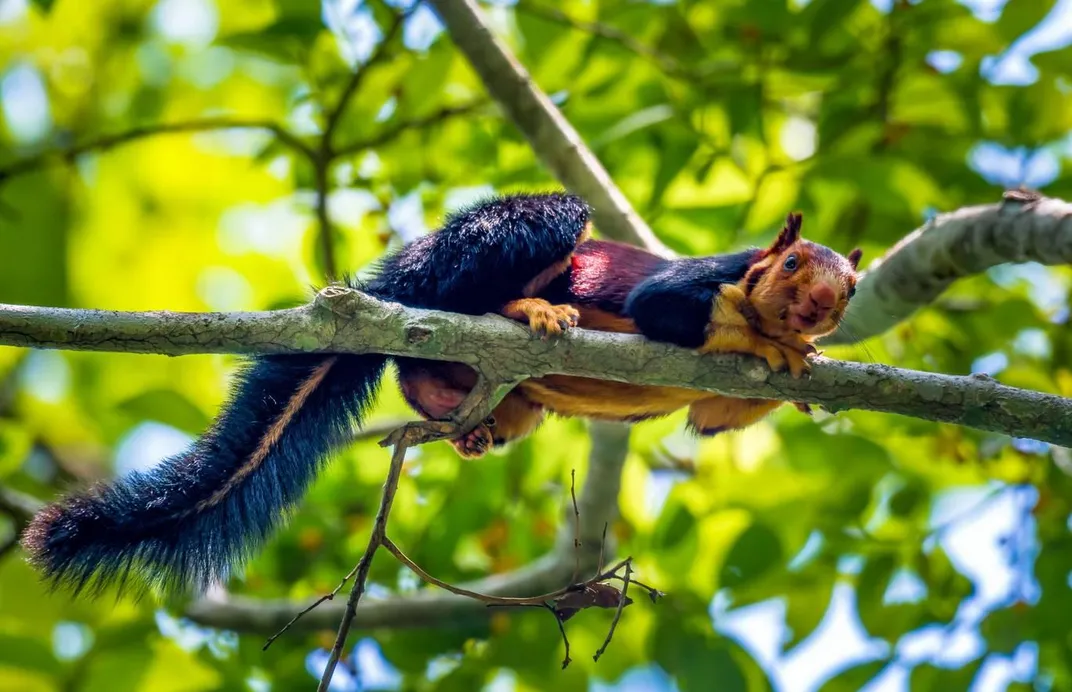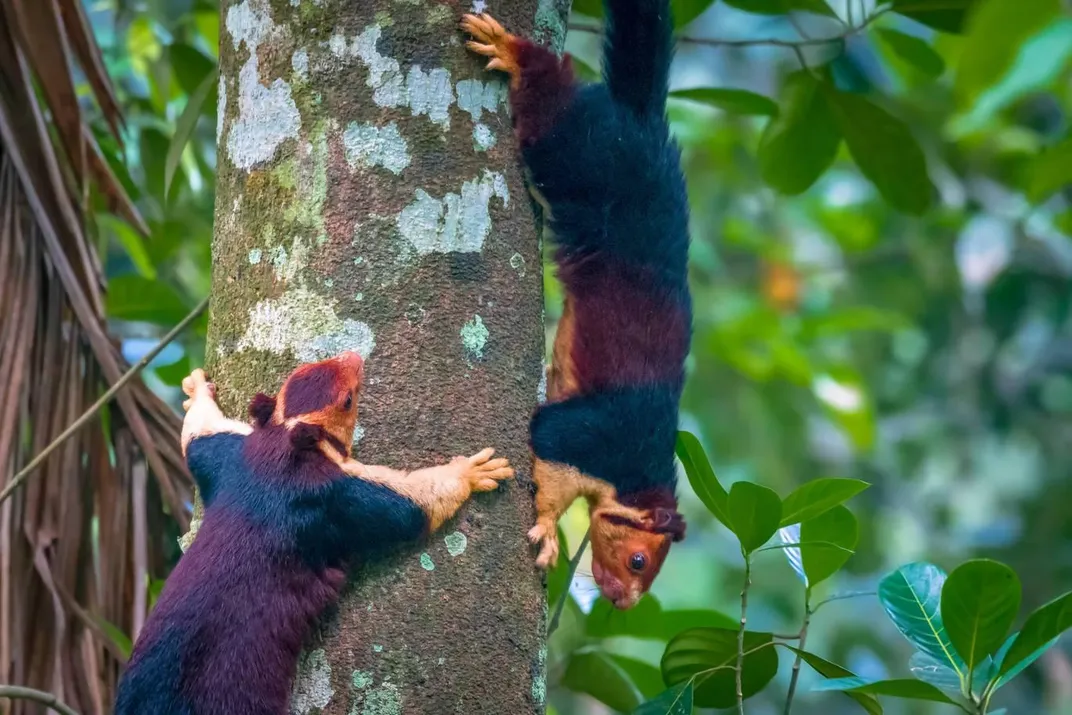Yes, Giant Technicolor Squirrels Actually Roam the Forests of Southern India
The colorful creatures can measure up to three feet long from head to tail and weigh in at around four pounds
/https://tf-cmsv2-smithsonianmag-media.s3.amazonaws.com/filer/63/91/639123ca-baed-482a-857f-9c048d4a7081/multicoloured-squirrel1.jpg)
The multi-hued, three-foot-long squirrels currently taking the internet by storm are no Photoshopped mythical creatures.
As Jason Bittel reports for National Geographic, the colorful four-pound critters—enjoying a renewed burst of attention thanks to a series of snapshots posted on Instagram by amateur photographer Kaushik Vijayan—not only roam the forests of southern India, but also, in the words of wildlife conservation biologist John Koprowski, look “exactly” like the majestic orange-, purple- and maroon-colored animals seen on Vijayan’s feed. (Give or take a few filters, that is: Evolutionary biologist Dana Krempels points out that the photographer may have enhanced the squirrels’ natural coloring by applying a “vibrance” setting.)
Officially known as Ratufa indica, or the Malabar giant squirrel, the species is one of four relatively hefty rodents in the squirrel family.
Incredible #pictures of giant multi-coloured squirrels set #social media alight!#Photographer Kaushik Vijayan snapped the animals in their native habit. The Malabar Giant #squirrel - double the size of their grey relatives - live deep in the #forests of #India. pic.twitter.com/BLFRZf6VHy
— SWNS.com (@SWNS) April 2, 2019
“The four species that make up this group are fascinating in their large size, brilliant coloration, and penchant for feeding on some of the massive tropical fruits in the tree canopy,” Koprowski tells Bittel.
Although these companions match the Malabar squirrel in sheer mass, they have decidedly less technicolor coats: Ratufa affinis, found in Thailand, Malaysia, Singapore and Indonesia, has brown or tan coloring, while Ratufa bicolor, as its name suggests, is mainly black and white. Ratufa macroura, also dubbed the Sri Lankan giant squirrel, bears two-toned shades of black and grey.
According to the Independent’s Chiara Giordano, Malabar giant squirrels can measure up to 36 inches, or three feet, from head to tail. Their better-known grey, red and black relatives (such as the friendly eastern greys common across North America) are roughly half this size.
Impressively, the giant rodents are capable of jumping 20 feet between trees. And this is far from their only special skill: As John Wible, curator of mammals at the Carnegie Museum of Natural History, explains to National Geographic’s Bittel, the squirrels create food stores in treetops high above the forest floor. Comparatively, most squirrels hide their seeds and nuts underground.
Vijayan spotted the purple-hued animal in question while visiting a forest in India’s Pathanamthitta District. “I felt so amazed by how drop-dead gorgeous it looked," he told CBS News’ Christopher Brito. "It was indeed a jaw-dropping sight to behold."
Malabar squirrels were listed as a vulnerable species some 20 years ago, Mike McRae writes for Science Alert, but their numbers have since stabilized. In 2016, Badri Chatterjee observed for the Hindustan Times, a census found that the giant squirrels had actually experienced an eight percent bump in population across the Indian districts of Pune and Thane.
It remains unclear why the giant creatures boast such vibrant colors. Although these shades provide a boon for nature photographers, they could prove to be a liability in forests where such creatures as lion-tailed macaques, leopards and crested serpent eagles are on the hunt for hapless rodent prey.
McRae posits that the Malabar squirrels’ coloring helps them blend in with the contrasting hues of the forest’s canopic covering, or perhaps attract a mate’s attention. Speaking with Bittel, Koprowski expands on the former theory, noting that their markings may enable squirrels to camouflage themselves among the forest’s “mosaic of sun flecks and dark, shaded areas.”
/https://tf-cmsv2-smithsonianmag-media.s3.amazonaws.com/accounts/headshot/mellon.png)



/https://tf-cmsv2-smithsonianmag-media.s3.amazonaws.com/accounts/headshot/mellon.png)